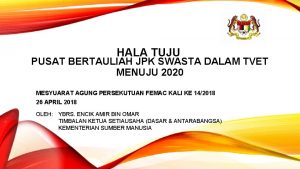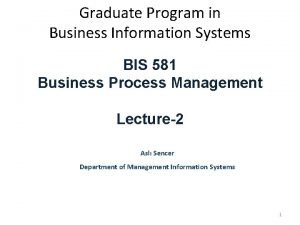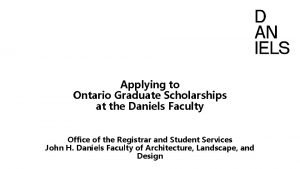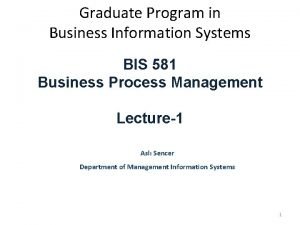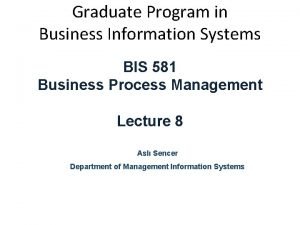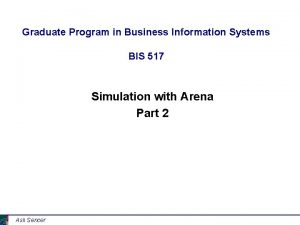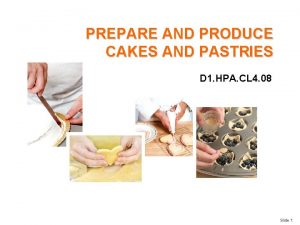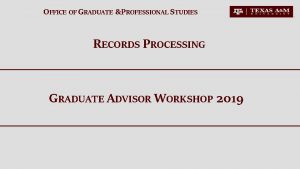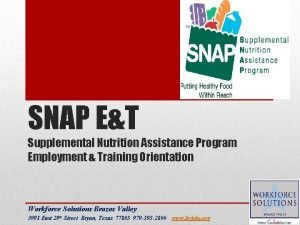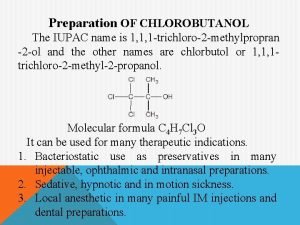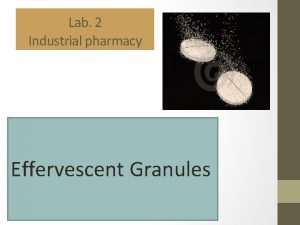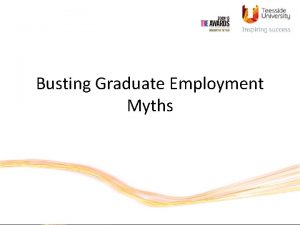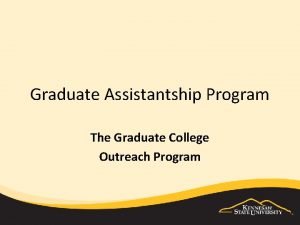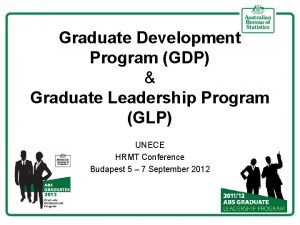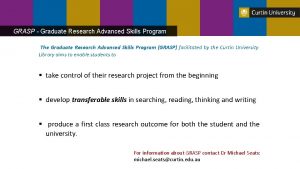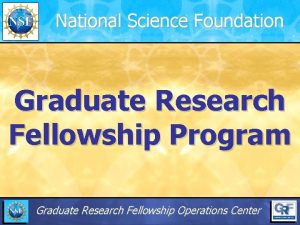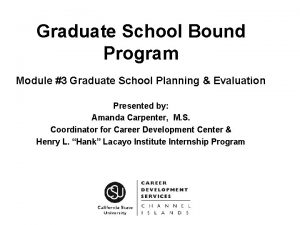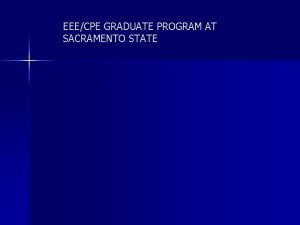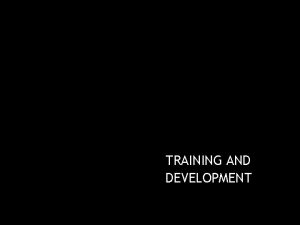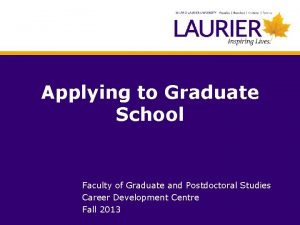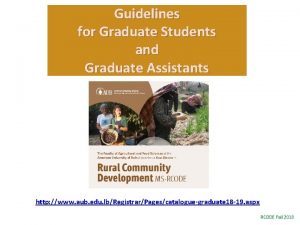Graduate Training Program How To Prepare and Prepare





















- Slides: 21

Graduate Training Program How To Prepare, and Prepare for Your Qualifying Exam

A. General Procedures: • taken by the end of 2 nd year, certainly by October of 3 rd year • choose the right committee members • be sure you meet with your committee members often before the exam to have approval of specific topic area AND general outline of Specific Aims • read, read ---- and then read some more

B. Purpose of the Exam: • “…whether the student is qualified and competent to continue research on a specific project leading toward the Ph. D” • potential for independent thought • comprehension of generalities and specifics of the research area (and everything related to that area) • ability to identify a critical (and significant) problem, and then critically and logically approach the problem (i. e. What are the knowledge gaps and critical questions to be addressed? , What are the critical experiments to answer the questions? ) • committee to advise on the path for the project - as such, the exam itself should be viewed as, in part, a learning experience

C. About the Project: • should address a significant issue, yielding publishable results • a good and innovative idea • linkage to the particular discipline (e. g. immunology, genetics, toxicology, etc) and human health • have a clearly focused and mechanistic hypothesis (i. e. not descriptive)

D. Common Problems: • overly ambitious • lack of significance and/or some linkage to human health (I. e. don’t let a committee member say “So what? ”) • lack of a focused hypothesis --- and in some cases ANY hypothesis • lack of focused aims that will test the hypothesis • lack of a logical research plan • questionable reasoning in approach • using approaches that will only test the hypothesis indirectly, or will not give you the data you need • poor writing that is not thorough and detailed • lacking good scientific method/approaches • did not read, read…. .

E. Keys to Success: • know the research area -- read, read • get help from each of your committee members - have each committee member approve the general outline of your proposal • write clearly, to the point, but be detailed and thorough • engender enthusiasm in your reader (i. e. committee) • clearly indicate what is novel and important • be logical, scientific, and specific - don’t use jargon • don’t over-interpret - realize the limitations of each experiment, and alternate approaches • use accepted (state-of-art / novel) and optimized scientific methods / approaches • discuss your hypothesis/hypotheses with other colleagues

E. The Written Proposal: • ariel, 11 font, 1 inch margins E. 1. Abstract: summary of the proposed project • be sure states the critical issue(s) to be tested, why important, the central hypothesis, and general approaches to be used • Briefly answer - What to do? - Why do this? - How do this? - Evidence when done? (expected results) - Why anyone cares?

E. The Written Proposal: E. 2. Specific Aims: (1 page) • state long-range goal of the research • identify critical knowledge gaps and why important to address these - What will be the expected scientific impact of the work? • statement of central hypothesis • listing of 2 -4 specific aims: • for EACH aim state concisely and realistically the hypothesis to be tested, and the rationale • for EACH aim briefly (1 sentence) state what the Aim will accomplish • NOTE: This is probably the most important part of the written exam. It sets the tone for the rest and gives a logic to follow in the remainder of the document.




E. The Written Proposal: E. 3. Background and Significance (3 pages): • logical development of background relevant to the problem, global to more specific. • state concisely what is known (Hint: A positive statement about knowledge as the beginning of a paragraph. This is a “take home” message. ) • identify critical knowledge gaps and needs, and why it is important to fill these • relate these needs to the specific hypothesis you are testing • relate these needs and your hypothesis to some public health benefit • Innovation: clearly state what is innovative

E. The Written Proposal: E. 4. Preliminary Studies: • students not expected to have a large amount of data • the data shown should demonstrate the problem and/or the feasibility of the research • only show the most important and relevant data; simple graphs/tables with precise legends (Hint: Give a positive statement as the title of the graph/table) • most faculty like the graphs/tables incorporated into the text (but can include at end of section; but don’t exceed page limits) • contributions of others specifically stated

E. The Written Proposal: E. 5. Experimental Design & Methods (10 pages): • discuss in detail the experimental design and procedures to be used to accomplish Specific Aims • this should be in a logical progression, give tentative time-table • describe new methods and advantages over older methods • describe expected data, limitations of interpretation, and alternative approaches (recognize that an experiment could have more than one possible outcome, as well as interpretation)

E. The Written Proposal: E. 5. Experimental Design & Methods (cont. ): • Developing rationale for approaches, a logical flow of experiments, and critical interpretation are more important than some details (i. e. buffers, etc). But you need to KNOW details, and be able to justify details such as choice of cell line, p. H, concentrations of agents, times of analysis. YOU MUST KNOW THEORETICAL BASIS FOR EACH METHOD AND APPROACH USED. • Hint: sub-sections for 1) Rational & Hypothesis, 2) Strategy, 3) Experimental, 4) Expected Results Possible Difficulties, Alternate Approaches for each Aim. • Indicate how data will be analyzed (i. e. statistics, and Power calculation to be sure have enough N)

E. The Written Proposal: E. 6. Bibliography: • names of all authors, title, book or journal, volume number, inclusive page numbers, year of publication.

E. After You Finish Writing: • Have someone else read the proposal before submitting to your mentor. • Have your mentor read the proposal WELL before you submit to the Dean’s office and rest of your committee. • Don’t ignore the feedback you are given. • You must submit the proposal to your committee at least 2 weeks before the exam date.

F. Preparation for the Actual Exam Day: • KNOW EVERYTHING there is to know about your area of research • Anything you learned in classes is also free game for questions - BUT the committee will likely only go after these if related to your research area, and knowledge of this is important for your experimental design and/or interpretation of data. • Get a good nights sleep, relax, and have fun -- really.

G. The Day of the Exam: • exam lasts 2 -3 hours (but be prepared for 4 -5) • judged on - written presentation of proposal - ability to critically evaluate a research area, propose a relevant hypothesis, and design critical experiments - grasp of fundamental issues and theoretical basis for experimental approaches - logic of experimental design & scientific method - how to critically interpret data (don’t over-interpret) - knowledge of alternate approaches • be ready to listen, learn, and share knowledge

G. The Day of the Exam (cont. ): • If you don’t understand the question, ask to repeat • If you don’t know the answer, logically think about how to get the answer, I. e. “I don’t recall the specific details or I don’t recall if anyone has ever examined that - but these are the types of studies I would do to address that issue. ” Don’t BS -- the committee will know and the hole that is being dug will get deeper. • If you have some knowledge that may be contrary to what a committee member indicates, don’t be afraid to respectfully indicate that -- the committee member may not know the research area as well as you do. • Be confident (not flippant or impudent). Realize that knowledge gives confidence (i. e. read, read). If you are not confident, the committee will know. Don’t be intimidated…

H. After the Exam: • If you have followed ALL of the directions in this presentation – then CELEBRATE : ) (at least for a couple of hours – then get back to work) • realize that you still have to - do all of the studies that you indicated - change experimental plans as necessary; sometimes these should change - consult often with your committee - write manuscripts - prepare your thesis and take the final Defense (which is not a given for a “PASS”) • if you have not followed the directions in this presentation – seriously consider the options…
 Hala tuju tvet
Hala tuju tvet Bis graduate program
Bis graduate program Ogs application deadline
Ogs application deadline Woolworths graduate program
Woolworths graduate program Oscar hosking
Oscar hosking Bis graduate program
Bis graduate program Talent accelerator program
Talent accelerator program Bis graduate program
Bis graduate program Bis graduate program
Bis graduate program Auchan graduate program
Auchan graduate program Prepare and produce cakes and pastries
Prepare and produce cakes and pastries Ogaps tamu
Ogaps tamu What does abawd mean
What does abawd mean Rockefeller professional development
Rockefeller professional development Seta program 5 steps
Seta program 5 steps Sequential program and an event-driven program
Sequential program and an event-driven program Hot and cold
Hot and cold Prepare and display petit fours
Prepare and display petit fours Iupac of chlorobutanol
Iupac of chlorobutanol Bottle gum method
Bottle gum method How to prepare an income and expenditure account
How to prepare an income and expenditure account Example of granules in pharmacy
Example of granules in pharmacy
